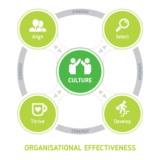
Are you using meaningful data to help successfully onboard your new team members?
Do you remember the feelings you have before starting a new job? The trepidation or nervousness mixed with excitement and enthusiasm to get in there, meet everyone and discover your new environment. After a few days, these emotions settle and then comes the learning curve; understanding the ins and outs of your new role and assimilating to your new working rhythm. Over the next few months, you maintain a heightened sense of focus required to absorb new knowledge or build new skills, so that you can emerge standing on your own two feet, being productive and adding value to the organisation.
Welcome to your onboarding process! This is technically defined as the mechanism through which new employees acquire the necessary knowledge, skills, and behaviors in order to become an effective organisational member.
“The First 90 Days” author and researcher, Michael Watkins has found that individuals who are successful in the first few months, are likely to have continued success for at least the next 3 years. The onboarding process plays a significant role in this. While employees have some control over some work elements, such as their motivation, persistence, abilities and competencies, a greater portion of the control lies with the employer, who decides the quality, content and structure of the onboarding process; all of which will play a hand in determining whether your new staff members are set up for success.
Make no mistake, the onboarding process can be a make or break experience for a new employee. It can impact your organisation’s performance and culture.
The importance of using a quality, tailored and fit-for-purpose onboarding process
While some elements of onboarding need to be standardised, most roles will benefit from a tailored, fit-for-purpose onboarding process to account for individual differences. In doing this, as an employer you can make an excellent first impression for your new employees. It instils confidence that your organisation is setting them up for success; it demonstrates credibility that your organisation has good practices; and importantly, it shows them that you care. Done poorly using a cookie-cutter approach or tick-box exercise that lacks structure, commonsense and/or key information, can leave a new employee confused and dissatisfied. In addition, it can be a waste of company resources because the individual can take much longer to do their role and add value.
How employers can tailor the on-boarding process by using existing data
Chances are that your new employee has gone through a recruitment process where the hiring manager and/or recruitment partner has established all, or some of the employee’s:
- Skills, knowledge, experience & competencies
- Qualifications
- Values or motivations
- Culture fit
- Strengths
- Development areas
If you use high quality psychometric assessments in your recruitment process, the hiring manager and/or recruitment partner will have even more valuable and objective data that can give insights into the employee’s:
- Personality, to understand their unique behaviours, preferences and tendencies in the workplace
- Cognitive abilities, to demonstrate an individual’s ability to learn new and complex information quickly or their general ‘intellectual horsepower’, as well as their potential to critically evaluate verbal or numerical information.
Consider you have two new employees starting the same position. Sure, many elements around compliance, process and systems may be standardised, but depending on the data you collected during their recruitment phase (the above bullet points), their onboarding paths may deliberately dissect at some point. For example, employee A may be stepping up into the role. They may have many existing capabilities and skills that are required for the role, such as leadership capability, resilience, influencing skills and building relationships, but they also have clear developmental gaps, such as not having delivered a strategic agenda or lacking specific industry knowledge. Employee B is side stepping into this role – your due diligence suggests they have the key capabilities, knowledge and skills to successfully perform the role. Their only clear gap is their understanding of the unique and complex businesses challenges – you expect employee B to hit the ground running, sooner rather than later.
The objective for both employees is to fast track them into their roles by arming them with the right knowledge, connecting them with the right people, leveraging from their strengths and closing the gaps on their development areas. A good onboarding process will strategically have these prioritised. What needs to be done in the first 8-12 weeks versus what can wait until the 5-6-month mark?
Employee B’s onboarding process should prioritise building their understanding of the unique business challenges, so you may allocate ample time to meet and work closely with key stakeholders to accelerate their understanding.
For the person who is stepping up (employee A), they will need a more considered path. While they may immediately be able to fulfil aspects of the role, there may be other pressing needs to upskill in the areas you identified in the recruitment process, in which case you could create an intensive, blended learning plan that includes e-learning, readings mixed with on-the-job practical experience where they initially observe others in the role and then complete key tasks under supervision followed by feedback. Other job elements may enter the onboarding process later down the track to avoid overload and confusion.
You may see that if Employee A was given Employee B’s onboarding process, they may become bored and disengaged. The other way around, they might become overwhelmed and confused. Both would no doubt become frustrated and their performance would suffer.
Using a development plan during the onboarding process
Very rarely does the perfect job candidate exist. There are usually, if not always gaps or development areas that can be improved upon. At Steople, we use psychometric assessments for our clients during the recruitment process. Not only does this information help inform our clients with the selection process, it is invaluable information for the successful candidate when they start the role, and also for the hiring manager who will benefit from understanding their new employee’s abilities, personality and how their preferences will play-out in the workplace. For example, are they receptive to feedback? Are they likely to be confident and resilient? Are they likely to cope under pressure and uncertainty? Do they tend to be supportive of others? How do they like to learn and are they quick learners? There is lots of useful information the manager could benefit from understanding about their new staff member that can be integrated into the onboarding process.
At Steople, we often meet with the successful job candidates and provide them with a debrief in the form of feedback from their psychometric assessment results. Some of this feedback is then used to start a development plan where goals are formulated to set them up for success. For example, Employee A, stepping-up is very keen to learn and is highly receptive to feedback, however they are much less structured than most and dislike being overloaded. Further, they have slightly lower cognitive abilities, so will take additional time to learn. Given this individual is going on a steep learning curve in the next 6 months, one of their goals may be around clear and visible organisation and prioritisation to ensure they are working efficiently and effectively. They might also have a special focus summarising their learnings each week and sharing this with their manager (who is aware to give more feedback than usual) so they consolidate information learned and stay accountable to their goals.
Employee B’s profile suggests they are very inclined to challenge people and are likely to forge ahead with decisions rather than consult with others. While this may be a blind spot for employee B, they tend to agree and decide to set a goal to consciously slow down, listen and consult with others before making decisions, particularly while they are learning about the business.
In summary, there is plenty of valuable data that you can draw upon to design a well considered, fit-for-purpose onboarding process for new employees that will help them succeed in their role, so that they can quickly start performing effectively and adding value to the organisation. They will also be more likely to enjoy their new role.
What data are you capturing and are you making the best use of it? If you’d like to know more about this, please contact your nearest Steople Office and we can discuss your needs.


